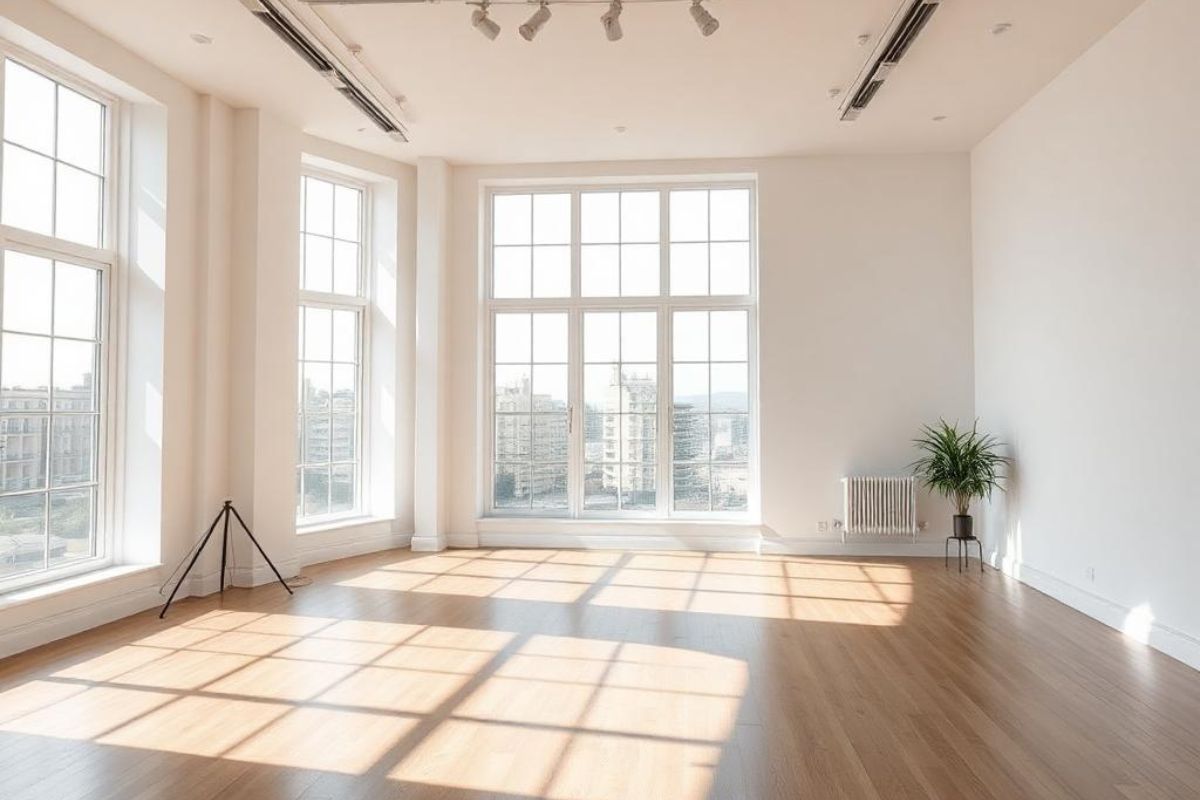Floor-to-ceiling windows transform a workspace into something airy, uplifting, and visually engaging. They bring the outdoors closer, reduce the feeling of confinement, and influence how colors, furniture and décor interact with abundant light. Such windows act as focal points rather than mere architectural features. In this blog, we’ll outline seven creative strategies to decorate a room with floor-to-ceiling windows.
Emphasize Natural Light with Thoughtful Furniture Placement
Studies link generous natural light exposure to reduced symptoms of depression, enhanced mood, and improved mental well-being, highlighting the value these windows bring to an office or room.
Positioning furniture in a room dominated by floor-to-ceiling windows involves careful attention to function and aesthetics. Placing a desk parallel to the window encourages natural illumination across the workspace without forcing direct sunlight into the eyes.
Pulling seating slightly away from the glass allows light to flow freely into the room and prevents the furniture from feeling cramped against the window wall. Chairs near these windows can serve as inviting spots for breaks, reading sessions, or casual chats, all while allowing the occupant to gaze outside and reset mentally. A few low shelving units or side tables remain useful without overshadowing the openness that the windows provide.
This balanced arrangement treats the windows as a starring design element and enhances the sense of spaciousness throughout the studio or office.
Introduce Textiles that Complement the Windows
Textiles play a big role in shaping the atmosphere within a window-rich space. Selecting fabrics and materials that echo the tones seen outdoors can create a seamless indoor-outdoor dialogue. Try the following suggestions:
Choose rugs in subtle patterns or nature-inspired hues, such as soft greens or sandy beiges, to ground the room.
Add cushions and throws in complementary colors found outside.
Incorporate textured upholstery, like woven fabrics or organic fibers, to soften the room’s hard surfaces.
Tip: Pair these textiles thoughtfully so they never outshine the view outside.
.jpeg)
The Best Window Treatments for Floor-to-Ceiling Windows
High-quality motorized shades offer an elegant solution for tall expanses of glass. They protect furnishings from UV damage, create privacy when needed, and adjust lighting conditions with the touch of a button. Their sleek profile suits a modern aesthetic, and they operate quietly and efficiently. The result is a comfortable balance between open and closed, bright and shaded, private and inviting.
Add Greenery to Merge Indoors and Outdoors
Integrating plants near floor-to-ceiling windows encourages a living connection between the inside and outside worlds. Indoor plants can filter harmful pollutants like VOCs (volatile organic compounds), reduce CO2 levels, and increase humidity, contributing to healthier air quality. When selecting plants, consider species that adapt well to bright conditions and offer interesting shapes or foliage, such as the following:

Positioning a combination of these plants along the window’s edge or in a corner emphasizes the link between interior style and the environment beyond the glass. Their growth, subtle changes in color, and seasonal variations constantly renew the ambiance, making the workspace feel alive and evolving.
Curate Art and Décor That Reflect the View
Incorporating art is another effective way to style a room with large windows.
Art and décor can highlight the external scene visible through large windows rather than competing with it. Landscapes, nature photography, or abstract pieces inspired by local colors connect the room’s personality to its surroundings. Mirrors placed strategically opposite the windows reflect natural light and the outdoor scenery, amplifying depth and brightness throughout the space.
Décor items crafted from organic materials—wooden sculptures, stone vases, or ceramic planters—reinforce the natural link, while subtle accents like a bowl of smooth river stones or a collection of shells further connect interior design and the outdoors.
Use Lighting Solutions to Complement Natural Illumination
When the sun sets, artificial lighting maintains the functionality of an office or studio. Light fixtures should support, not overshadow, the daytime brilliance. The table below offers a quick overview of various lighting solutions and their roles in a window-centric workspace:

Selecting lamps with warm hues prevents a stark contrast after dark. Using dimmers and layered lighting arrangements offers versatility, allowing the mood to shift from bright and productive to warm and relaxing as the evening deepens.
Experiment with Modular and Moveable Furniture
Floor-to-ceiling windows bring an airy openness to a space, inspiring a flexible approach to furniture layout. Modular and easily rearranged pieces are ideal for adapting to different activities, shifts in natural light, and evolving preferences. Here are some creative ways movable furniture can enhance versatility and functionality in your home:
Select lightweight desks or tables that roll, fold, or stack for quick reconfiguration.
Use movable partitions or folding screens to adjust privacy or divide the space temporarily.
Incorporate shelves on casters to shift storage where it’s needed most.
Opt for chairs and stools that can nest together or slide beneath tables when not in use.
Tip: Rearrange seating periodically to rediscover fresh vantage points and invigorate the room’s energy.
Incorporate Subtle Color Schemes That Highlight the Views
Color choices in a room with expansive windows can impact the beauty of the outdoor view. Soft, understated palettes like crisp whites, creamy beiges, gentle greens, or pale blues create a seamless flow between the interior and the natural panorama. These tones work harmoniously with natural light, letting the view take center stage.
To add subtle contrast, incorporate a few accent pieces in brighter hues without overpowering the overall design. This balanced approach fosters a serene, connected atmosphere that complements the outdoor scenery while promoting focus and well-being.
Conclusion
Floor-to-ceiling windows introduce a rare opportunity to engage with both form and function in an inspiring work setting. Creative choices in furniture, textiles, greenery, art, lighting, and color cultivate a room that transcends the ordinary. Adjusting these details over time ensures the space remains vibrant and aligns with evolving trends or productivity goals.






Share: